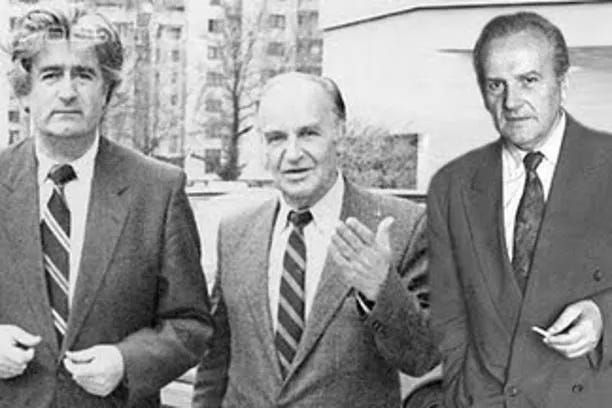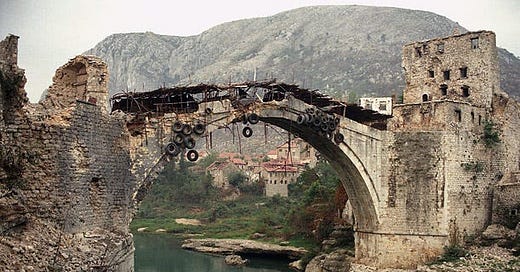S4E10. The Ghost of 1993 past, present and future
A brief summary of the third year of dissolution of Yugoslavia, exactly 30 years ago. Month by month, the timeline of the events with BarBalkans' podcast, discovering the fate of the European history
Hi,
welcome back to BarBalkans, the newsletter with blurred boundaries.
On the occasion of the last episode of 2023, our tradition is to look back over the past year with BarBalkans’ time machine.
If you are familiar with BarBalkans you already know it, if you have recently joined us you will discover it soon. Alongside the biweekly newsletter, there is a parallel path following the dissolution of Yugoslavia 30 years ago.
Month after month, The Yugoslav Wars podcast is taking us back in time, to the decade that sealed the fate of recent European history.
To kick off 1994 (or rather 2024) together, all you need to do is a small donation.
Every second Wednesday of the month, you will receive an email - only for subscribers - with the story of what happened in that very month 30 years ago.
Today, we rewind the tape and discover the highlights of this year.
1993.
In this newsletter you will find the link to each episode. The text content is reserved to subscribers, but here you can get an overview of the events. You can freely listen to all the podcasts on Spreaker and Spotify.
The third year of war
Year 1992 ended with President Slobodan Milošević’ triumph at the elections in Serbia and with the “Christmas warning” from Washington on Serbian extremist hegemony in Kosovo. But Bosnia and Herzegovina is still the epicenter of the war.
In January, fighting escalates along the Drina River (which divides Bosnia from Serbia eastwards) between the Army of the Republic of Bosnia and Herzegovina and the Army of Republika Srpska, with repercussions on Sarajevo. The Bosnian Deputy Prime Minister, Hakija Turajlić, is killed in cold blood by Bosnian Serb paramilitaries while he is traveling on a UNPROFOR armored vehicle.
However, the focus of diplomacy is on the peace plan for Bosnia and Herzegovina, the Vance-Owen Plan. It recognizes the existence of 3 constituent peoples (Serbs, Croats and Bosniaks) and a complex system of ethnic-majority provinces and a central government.
While the new U.S. President, Bill Clinton, makes his debut on the international scene in February with many turnarounds, a historic event goes almost unnoticed.
On February 22, the UN Security Council adopts the resolution establishing the International Tribunal for the former Yugoslavia, to prosecute those responsible for war crimes, crimes against humanity and genocide since 1991.

The situation becomes increasingly dramatic for the Bosnian civilian population. The town of Cerska falls immediately in early March. Thousands of refugees arrive in Srebrenica, where tensions is now almost unbearable.
For this reason, the President of Bosnia and Herzegovina, Alija Izetbegović, is forced to sign the Vance-Owen Plan. He is trying to prevent the disappearance of Muslim Bosnians, after the betrayal of Western promises about maintaining a united, sovereign and democratic country.
The President of the Croatian Republic of Herzeg-Bosnia, Mate Boban, also accepts the peace plan, since the provinces assigned to Bosnian Croats - two in Western Herzegovina and one in Posavina - share common borders with Croatia.
On the contrary, the President of Republika Srpska, Radovan Karadžić, risks to see the dream of Greater Serbia fading away: two of the three provinces assigned to Bosnian Serbs would be separated from Serbia.
This is how the conflict between Serbs and Bosnian Serbs flares up in April. Karadžić’ refusal to ratify the peace plan is causing heavy international sanctions on the Federal Republic of Yugoslavia, that is already suffering a critical economic crisis.
As it tries to rekindle hope in the Vance-Owen Plan, the UN classifies Srebrenica «safe area». This is an attempt to avoid the surrender of the city in Eastern Bosnia, that could result in Serbian disinterest in implementing the map of the future country.
In May, also Goražde, Sarajevo, Tuzla and Žepa are defined «safe areas», but the peace plan for Bosnia and Herzegovina is agonizing. The unwavering Bosnian Serb opposition is confirmed by a popular plebiscite.
Serbian President Milošević is furious and decides to impose sanctions against Republika Sprska: the border along the Drina River is closed to all incoming supplies from Serbia and Montenegro.
Meanwhile, along the valleys of Neretva (Herzegovina) and Lašva (Central Bosnia) rivers, ethnic hatred between Bosniaks and Bosnian Croats is increasing. Mostar - a city with a population of 130 thousand people and with a harmonious ethnic composition until the outbreak of the war - becomes the epicenter of massacres and armed clashes.
From one peace plan to another
At the beginning of summer, fighting intensifies both in Central Bosnia - where Bosniaks reorganize against Bosnian Croats - and around the town of Goražde, where Bosnian Serbs focus their attacks before the entry into force of the resolution formalizing the «safe areas».
Meanwhile, Serbian President Milošević reactivates contacts with his Croatian counterpart, Franjo Tuđman, in June. He proposes the ‘return’ of Krajina to Zagreb in exchange for support to the ethnic division project in Bosnia.
The initiative of the two presidents is officially presented at the Conference on the Former Yugoslavia. Three ethnically homogeneous States bound by a confederal agreement and a symbolic central authority: a Republika Srpska, a Croatian Republic of Herzeg-Bosnia, and a Muslim Republic.

Cooperation on the ground between Bosnian Serb and Bosnian Croat troops in Central Bosnia forces the Bosnian President Izetbegović to accept what in July is becoming a new peace plan.
But this plan is born crooked. Starting with the tricky definition of “Union of the Republics of Bosnia and Herzegovina”, which does not solve the question of whether the country should become a federation or a confederation. But also the extent of territory controlled by Bosniaks and the status of Sarajevo.
Yet, the Owen-Stoltenberg Plan becomes reality in August. Bosnian Serbs will control 52% of the Bosnian territory, with all provinces connected from Western Bosnia to Eastern Herzegovina. Bosnian Croats are granted 18% of the territory, with Posavina (northeast) and Western Herzegovina strategically bordering Croatia. Bosniaks will control 30% of the territory: they lose temporarily Sarajevo and Mostar (administered by the UN and the European Community) and the access to the Adriatic Sea, while their four areas are all disconnected from each other (Central Bosnia, Srebrenica, Goražde and Western Bosnia).
The peace plan is rejected by authorities in Sarajevo. Meanwhile, the Bosnian army launches the “Neretva 93” operational plan: the goal is to penetrate southward, along the Neretva River valley, to attack the troops of the newly formed Croatian Republic of Herzeg-Bosnia.

As Sarajevo is totally encircled by the Bosnian Serb troops led by Ratko Mladić, a new major problem is in sight for the Republic of Bosnia and Herzegovina in September.
Against the intransigence of President Izetbegović and the nationalist enthusiasm of the bošnjak establishment - which finally rejects the Owen-Stoltenberg Plan - the leader of the “moderate” wing, Fikret Abdić, establishes the Autonomous Region of Western Bosnia.
This entity includes Velika Kladuša and Bihać and is inhabited by 90% Muslim Bosnians. The politician and entrepreneur - founder of Agrokomerc, one of the most important Yugoslav agricultural-industrial conglomerates in the Eighties - opens the fourth war front on Bosnian soil.

Starting from October, the new entity is financially supported by Milošević and Tuđman, and the People’s Defense of the Autonomous Province of Western Bosnia is supplied with weapons by Serbia and with oil by Croatia. Treaties of Friendship are signed with the Croatian Republic of Herzeg-Bosnia and with Republika Srpska, following the project of the division of the country in four entities.
Sarajevo is under siege from inside and outside. Within the city, a 20-hour military operation is needed to arrest the two warlords Musan ‘Caco’ Topalović and Ramiz ‘Ćelo’ Delalić. Even if their squads have contributed to the armed defense of the city, they have also imposed drug, arms and essential goods trafficking.
Outside Sarajevo, Bosnian Serbs and Bosnian Croats jointly block the emergency supplies, while the Croatian Defense Council (the army of the Croatian Republic of Herzeg-Bosnia) is more and more violent in Central Bosnia and Herzegovina.
Facing a military crisis, in early November Bosnian Croat troops destroy with several mortar shots the symbol of a united and multicultural Bosnia and Herzegovina: the Stari Most, The Old Bridge in Mostar built in 1566 on the Neretva River by order of Ottoman Sultan Suleiman the Magnificent.
The international diplomacy continues to look for a way out of the war. The European Union makes its debut at the negotiating tables with a new peace plan. The Juppé-Kinkel Plan does not differ a lot from the previous one, except for a larger share of territory for Bosniaks and the explicit lift of international sanctions on Yugoslavia.
The real change comes with the inaugural session of the International Criminal Tribunal for the former Yugoslavia. Its objective is to judge all those accused by the prosecutor of having «organized, instigated, ordered, or otherwise aided or abetted the organization, preparation or execution» of war crimes, crimes against humanity and genocide since 1991.
At the end of the year, another round of parliamentary elections takes place in Serbia, intersecting with those in Russia. With the victory of nationalists both in Belgrade and in Moscow, the fire of the “Orthodox brotherhood” is renewed especially in Republika Sprska in December.
Nothing changes in Sarajevo. Despite the truce agreed between the warring parties at the Conference on the Former Yugoslavia, the city is besieged also on Christmas day.
The Juppé-Kinkel Plan is running toward failure. Also considering U.S. President Clinton’s fears that the division of Bosnia and Herzegovina into three entities could result in the creation of a Greater Serbia, a Greater Croatia and a Greater Albania in the Balkans. Against the will of authorities in Washington.

‘The Yugoslav Wars’ now continues with the events of 1994, month by month. Starting with the second Wednesday of January. Subscribe to BarBalkans’ podcast to follow this story.
Pit stop. Sittin’ at the BarBalkans
We have reached the end of this piece of road and of this year.
Like every end of the year, we deserve two Balkan specialities to warm up this winter day.
At our bar, the BarBalkans, we find a small glass of hot rakija, one of the most typical Balkan Christmas drinks, very easy to prepare.
And then, there is a cup of kuhano vino, the Balkan mulled wine. The wine is boiled with a combination of nutmeg, cloves, cinnamon, sugar, orange juice and zest.
Let’s continue the BarBalkans journey. We will meet again in two weeks, for the 11th stop.
A big hug and have a good journey!
If you have a proposal for a Balkan-themed article, interview or report, please send it to redazione@barbalcani.eu. External original contributions will be published every last Friday of the month in the Open bar section.
Your support is essential to realize all that you have read. And to keep BarBalkans newsletter free for everyone.
Because an increasingly original product needs many hours and energy, taken away from free-time for a while longer.
Studying, interviewing, writing, organizing events, editing external contributions, translating newsletters and recording the monthly podcast on the dissolution of Yugoslavia.
An independent project like this cannot survive without the support of readers, the real BarBalkans’ center of gravity.
Regardless of what you decide, just thank you.






